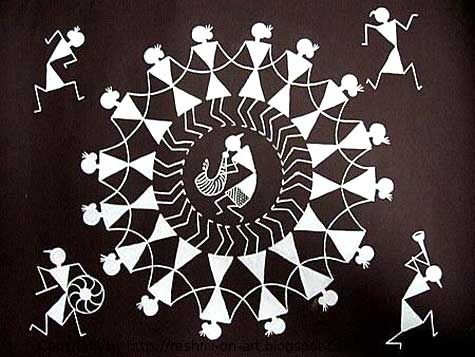
Warli Art: Unveiling the Elegance of India's Indigenous Tribe
Nestled in the heart of Maharashtra and Gujarat, the Warli tribe, or Varlis, beckon with their rich cultural tapestry and enchanting artistry. This indigenous community speaks the unwritten Varli language, a gem in the southern zone of Indo-Aryan languages. But it's their art, the mesmerizing Warli art, that truly captures the imagination. In this blog, we delve into the world of Warli art, revealing its captivating history, symbolism, and the stories it weaves.
Inside Warli Art: A Simple Yet Profound Vocabulary: Warli art captivates with its simplicity and profound symbolism. The artists use a basic graphic vocabulary consisting of a circle, a triangle, and a square. These elements are rooted in their deep observation of nature, with the circle representing the sun and moon, the triangle inspired by mountains and pointed trees, and the square, known as the "chauk" or "chaukat," taking center stage in every ritual painting.
Devchauk - God's Square: Devchauk is the sacred square, carefully outlined on the inside of a house wall. The intricate process begins by filling the square frame with geometrical strips. In the corners, you'll find symbols of the moon, the sun, a comb, a ladder, the tarpa (a wind musical instrument), and ghangli (a string instrument). At the center of Devchauk stands Palaghata, the mother goddess symbolizing fertility. Other figures include Pancha Sirya Dev, the five-headed god, and the headless warrior, representing the cosmic cycle of life and death.

Lagnacha Chauk - Marriage Square: Lagnacha Chauk, or the Marriage Square, is a celebration of wedlock. A decorative square is drawn, and married women depict a horse carrying the bride, groom, and groom's sister. Dancers, musicians, and dhavelris (women who perform the wedding) surround the horse, creating a joyous tableau.

The Tarpa Dance: Music, dance, and liquor hold a special place in Warli culture, and they have been dancing to the tune of the tarpa for centuries. The tarpa, a wind musical instrument, is considered a gift from the divine. During festivals like Diwali, young couples are summoned to dance in a circle to the mesmerizing tune of the tarpa. It's a joyful celebration of light, sound, and festivity.
The Artistic Technique: Warli paintings adorn the walls of huts, which are constructed from a mixture of branches, earth, and cow dung, creating a Red Ochre background for the art. These paintings use only white pigment, a blend of rice paste and water with gum as a binding agent. The "paintbrush" is a chewed bamboo stick, making it as supple as a paintbrush. These paintings often grace special occasions like weddings and harvests.
Conclusion: Warli art is not just a visual delight; it's a profound expression of the Warli tribe's culture, traditions, and deep connection with nature. When you bring a piece of Warli art into your life, you're not just adding decor; you're inviting the essence of an indigenous community's heritage. Each stroke and symbol tells a story of simplicity, symbolism, and the enduring spirit of the Warli tribe.
As you explore our collection of Warli-inspired treasures, we invite you to immerse yourself in the tales, history, and cultural significance behind each piece. Every purchase is an opportunity to connect with the beauty and heritage of India's indigenous artistry. Welcome to the mesmerizing world of Warli art, where simplicity meets profundity, and tradition transcends time.
